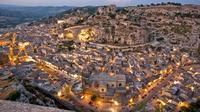Scicli Walking tour
Scicli, Italy
Trip Type: Walking Tours
Duration: 3 hours
Scicli is a town of refined culture, characterized by gullies and grottoes, by beds of torrents and the luxurious vegetation of gardens. Scicli maintains a harmonious relationship between man’s work and the natural environment. Destroyed in the Val di Noto earthquake and rebuilt in singular late Baroque forms it’s placed in a flat plan among three hills: San Matteo, Santa Croce and San Domenico hills.
It is also famous for being the location of the tv series Inspector Montalbano.
It is also famous for being the location of the tv series Inspector Montalbano.
More About This Activity All Walking Tours →
Scicli is a town of refined culture, characterized by gullies and grottoes, by beds of torrents and the luxurious vegetation of gardens. Scicli maintains a harmonious relationship between man’s work and the natural environment. Destroyed in the Val di Noto earthquake and rebuilt in singular late Baroque forms it’s placed in a flat plan among three hills: San Matteo, Santa Croce and San Domenico hills.
It is also famous for being the location of the tv series Inspector Montalbano. Our walk starts from Piazza Italia, framed by rows of eighteenth and nineteenth centuries buildings, where stands the present- day Mater Ecclesia: Sant’Ignazio. The façade, two levels surmounted by two pointed bell towers, is embellished with statues and a clock. Inside, the fascinating icon of Madonna delle Milizie, a statue inspired by the Madonna’s intervention in favor of the Christians and Normans during the battle against the Saracens in 1091.
It is also famous for being the location of the tv series Inspector Montalbano. Our walk starts from Piazza Italia, framed by rows of eighteenth and nineteenth centuries buildings, where stands the present- day Mater Ecclesia: Sant’Ignazio. The façade, two levels surmounted by two pointed bell towers, is embellished with statues and a clock. Inside, the fascinating icon of Madonna delle Milizie, a statue inspired by the Madonna’s intervention in favor of the Christians and Normans during the battle against the Saracens in 1091.
From Piazza Italia, ascending along the canyon from which it takes its names, you arrive at the Church of San Bartolomeo. Statues and columns with capitals of various styles decorate the pyramidal façade. The one nave interior has marble altars, colored stuccoes and one of the most beautiful crèches in all of Sicily, with linden wood statues executed by Pietro Padula in 1773-1776. Retracing one’s step , along the same street toward via Mormino Penna, you reach Palazzo Beneventano, with its exceptionally expressive and monstrous masks under its balconies. In the hearth of the town there is via Mormino Penna, Scicli’s most beautiful street, rich in monastic churches and patrician buildings.
The first church you meet is San Giovanni Evangelista, with an oval layout and a concave convex façade in accordance with schemes deriving from Borromini. Annexed to a Benedictine monastery, which became the Town Hall in the 19th century, the church holds inside a Spanish canvas of the Cristo di Burgos, depicting a crucified Christ wearing a white sacerdotal robe with chiaroscuro effects. The other major ecclesiastic church is San Michele, which rises in three levels and has an elliptical hall with a splayed portal to one side that creates an interesting play on perspective. Across from this side of the church rises another elegant example of late baroque art: Palazzo Spadaro. The last church to visit in this area is Santa Teresa, whose façade shows a rose window, three arches high up with a small bell tower next them.
« Go Back

